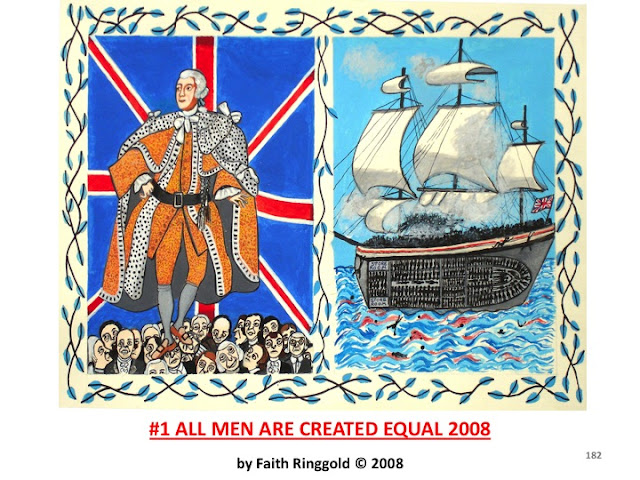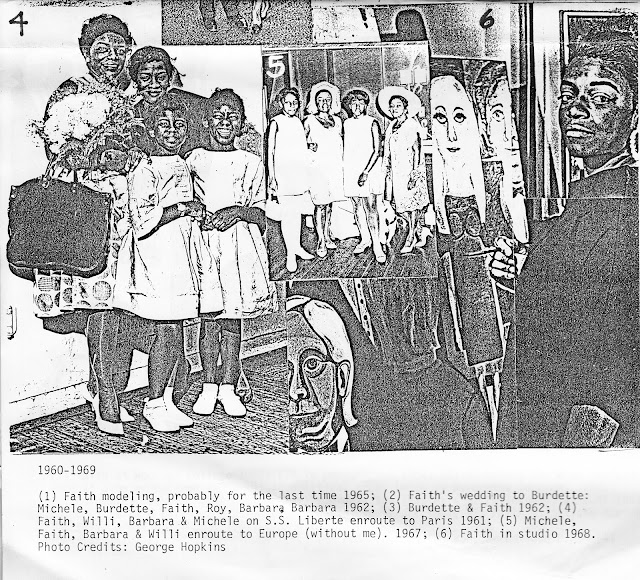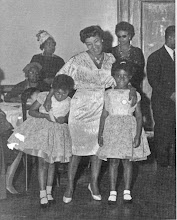This essay was written by me in conjunction with the 50 Year Retrospective exhibition of Faith's work at Rutger's University, and published in the catalogue.

Your country? How came it yours? Before the Pilgrims landed we were here. Here we have brought our three gifts and mingled them with yours: a gift of story and song—soft, stirring melody in an ill-harmonized and unmelodious land; the gift of sweat and brawn to beat back the wilderness, conquer the soil and lay the foundations of this vast economic empire two hundred years earlier than your weak hands could have done it; the third, a gift of the Spirit.
W.E.B. Dubois, The Souls of Black Folk (1903)
Primitive is a word I use in a positive way to explain the completeness of a concept in art. I like to layer and pattern and embellish my art in the manner of tribal art, and then, like a blues singer, I like to repeat and repeat it again. Fragmented, understated, or minimalist art forms frustrate me. I want to finish them. In the 1960s there was a minimalist aesthetic advocating “less is more.” To me, less is even less and more is still not quite enough. I was now using feathers and beads as never before.
I had been to the African source of my own “classical” art forms and now I was set free.
Faith Ringgold, We Flew Over The Bridge (1995)
In W.E.B. Dubois’ beautiful words on the cultural legacy of African Americans, which were written relatively early in a lifetime of struggle to uplift the race, one hears succinctly put the counter-claims of the African American experience in active contradiction with the utopian rhetoric of Thomas Jefferson’s Declaration of Independence. No, Dubois, seems to say, none of you who would call it your country have a claim that proceeds or outweighs the claim of the descendants of the slaves. It was the slaves, the kidnapped Africans who were here from the time of Jamestown in 1619 tilling the soil, contributing their flesh and sinew and ingenuity to build up this beautiful country, those 13 colonies, that the Founding Fathers would declare independent of the British crown.
It was the former slaves who would supplement the military forces of the colonies in the hopes of earning their freedom in a new nation. And for some time immediately after the Revolution, it seemed in some quarters as though slavery’s day was done. It was in this context that the Northern and Southern colonies struck the pact that would give slaveholders three-fifths of a vote for each of their slaves in the subsequent writing of the Constitution, helping to make their weight in national legislative bodies roughly equivalent to the non-slaveholders until the balance of power could not be maintained one minute more and the country itself faced a great Civil War.
Ironically, neither Dubois nor anyone else gave much thought to the potential for visual productivity among the slaves or even for the role of visual art in the lives of African Americans generally. When Dubois lists the African American contributions to the building of the land, the houses, the fences, the gardens and estates that the slaves made possible are considered unworthy of a mention. It follows then that it should be no surprise but when we turn to look for illustrations of the issues of race and gender in connection with the Declaration of Independence, we find precious little worthy of our respect and consideration. We find very little that can help enlighten us on the relationship of the Founders to their many slaves, and the future of those slaves. The women of any color were not even a thought.
Therefore when Faith turned last summer to the project of illustrating the Declaration of Independence, I took upon myself the task of finding what did exist among the images Americans invoke in celebration of the birth of the United States of America. I could find no visual images created specifically by African Americans in the 18th century at all bearing upon the rhetoric of the Declaration. Of the objects or images produced at the time of the American Revolution, I found some black artists: Joshua Johnston, the portrait painter who painted both blacks and whites, the slave potter from North Carolina known as Dave, the etchings by Scipio Moorhead (1773), among them one of the slave poet Phyllis Wheatley, the silhouettes of Moses Williams, who was a slave of Samuel Copley, the artist, including a silhouette of himself (in Portraits of a People: Picturing African Americans in the Nineteenth Century by Gwendolyn DuBois Shaw, Addison Gallery of American Art 2006).
With little in the way of precedents, Faith nonetheless devised six original images, each one double-sided with an image taken from the struggle of the American Revolution paired with an image relevant to the African American struggle for freedom and justice which continued for another two hundred and fifty years after the Revolution. First she made paintings of them as the basis for a series of lithographs with the help of her favorite Master Printer Curlee Holton, with whom she had collaborated on the prints included in The Jones Road Series and in the limited edition of Martin Luther King, Jr.’s, Letters from a Birmingham Jail (2007).
From the outset Faith knew she wanted to emphasize African slavery since we know that slavery was a vital aspect of the colonies and would remain crucial to the productivity of the new nation. But her biggest challenge turned out to be not representing the plight of African Americans in relation to the Declaration, but rather the plight of women.

It is no secret to anybody who knows me that I love to watch films and I love to read books. There are a lot of great books about slavery, and the books that consider the issues of the 18th century and the Enlightenment in relation to slavery form a distinct category in the field of American History. In the past two decades since the unearthing of the colonial slave burial grounds in lower Manhattan, our picture of the lives of slaves and the role slavery played in the colonies, particularly in the North, has been irrevocably altered and enhanced. (This material resulted in among other works the epic New York Historical Society’s Slavery in New York edited by Ira Berlin and Leslie M. Harris, The New Press 2005).
Whereas when I was a graduate student in American Studies at Yale University briefly in the early 80s and studied the history of slavery and abolitionism there, the colonial period was interesting yet still sketchy in terms of readily available secondary sources, now the secondary sources are both provocative and fascinating with work on the slave trade, itself, on the piracy on the high seas that resulted from it, on the development of abolitionism and African Diasporic contributions to the movement to end slavery, as well as such special works as Annette Gordon Reed’s Thomas Jefferson and Sally Hemings: An American Controversy, University of Virginia 1997, in which we learn about the fascinating connection between a family of slaves and the family of the most prominent of Founding Fathers.
I drew upon my background readings in the field to advise my Mom, such as most significantly the incomparable Inhuman Bondage: The Rise and Fall of Slavery in the New World (Oxford UP 2006) by my former teacher at Yale, arguably the most distinguished historian of abolitionism in the world today—Professor David Brion Davis. But Faith would insist upon visual sources, regardless the arguments I might make for the supremacy of concepts and ideas, and for the visual we turned together to the recent documentary work in the field. The best of these were the following:
Slavery and the Making of America Series produced by Thirteen/WNET New York 2004, Africans in America: America’s Journey Through Slavery Series produced by WGBH Boston 2006 and The Middle Passage produced by HBO 2003. But with precious few antecedent illustrations, paintings and sculpture to draw upon, no photographs and little in the way of a visual imagination, the palette of these documents remained largely monochromatic. Their artistic strengths lay largely in their use of music, in particular Slavery and The Making of America for which the celebrated African American musician Bernice Johnson Reagon wrote the score and performed much of the music, some of it with the help of her multi-talented daughter Toshi Reagon. I acquired as well the extended cds Reagon wrote and produced to accompany the production. Since the world of the slaves she is creating is as much a mystery in its musical composition as it is in its visual composition, Reagon uses her considerable knowledge of the history of African American music in the 19th and 20th century to reconstruct the music the slaves of the 18th century might have made, or might have understood if they had heard it. In the process, Reagon produces one of the most beautiful compilations of music I have ever heard, which served as an inspiration, albeit in the abstract, to Faith’s wonderful work.

Faith was particularly struck by Reagon’s rendering into song, WEB Du Bois famous words on the founding of the American nation, “Your country? How came it yours? Before the Pilgrims landed we were here,” which he addressed to his white readers in The Souls of Black Folk (1903).
But perhaps my fondest memory of our whole interaction during her completion of the project was viewing together the docu-drama of the life of John Adams produced by HBO that spring. From this riveting experience came Faith’s interest in the letters Abigail Adams wrote to her husband John Adams who was one of the signers of the Declaration. Sadly, this was as close as any woman in the 18th century got to having a verifiable impact on the contents of the Declaration.
In the second of her illustrations of the Declaration, Faith used a painted portrait image of Abigail Adams as her model, rendering it in black and white and juxtaposed it with a carte de visite photographic portrait of the 19th century black feminist orator Sojourner Truth. On these images Faith superimposed in turn the handwritten words by Abigail Adams in the 18th century concerning the rights of women and the words Truth spoke in her defense of the vote for women (which were not successful) at the conclusion of the Civil War.
Faith’s first image juxtaposes King George III against a background of the British Flag. He is walking on the heads of the American Colonists. King George III was the person to whom the Declaration of Independence was addressed. His response was extremely dismissive, which set off the American Revolution. Next to King George, Faith has set an image of a slave ship in which there is superimposed a diagrammatic portrayal of how the slaves were packed in the holds.
In the water are slaves either being dumped or jumping to their deaths, recalling most famously JW Turner's 19th century masterpiece “Slaveship.”
The third illustration "Absolute Tyranny" juxtaposes the portrayal of the Boston Massacre in which Crispus Attucks, an African American was the first to fall (a version of the images printed and circulated by Paul Revere) with a lynching scene in the American South.

The fourth illustration juxtaposes a rendition of The Boston Tea Party with an image taken from the famous photograph of the Civil Rights Confrontation on the Edmund Pettus Bridge some two hundred years later.

Illustration 5 juxtaposes an image of Benjamin Franklin pleading the case of the new nation before the British Crown after the American Revolution in 1776 with an image of Frederick Douglass addressing a hypothetical abolitionist meeting under the trees in the period after his escape from slavery in the 1830s.
Wherever the slave ships traveled on the high seas, there was an ongoing blood bath of contending forces. There was no justice. There was no peace.

Faith’s final image juxtaposes Thomas Jefferson writing the Declaration of Independence at his entirely slave-built estate in Montecello, Virginia with Martin Luther King writing Letter from a Birmingham Jail in his cell in 1963.
The Enlightenment was full of contradictions, including the Declaration of Independence which was arguably the first world historical document to result from Enlightenment ideas: equality yes but for rational, civilized human being, which as everyone knew included only white adult land-owning males. This was such an implicit assumption at the time of the writing of the Declaration, that these terms need not even be explicitly stated, leaving perhaps the loophole of the next two centuries which find us now with a President who descends from Africa and from America combined.
Of course, Thomas Jefferson, the most revered of our founding fathers and the author of the Declaration of Independence, thought that Africans were culturally inferior based upon some rather fanciful observations culled from existing readings of African cultures and his close observation of the African slaves he owned and carefully managed. His Montecello estate, where Faith pictures him quietly writing the Declaration, still stands today as a celebration of the beauty and careful design that he and his well trained and skillfully trained artisan slaves constructed. He kept his slaves and their families with him for life, if his finances didn’t interfere, and he also chose to have each of his slaves educated in a useful trade or craft contributing to the self-sufficiency of the beautiful Monticello. But they were still slaves, and even Sally Hemmings, whom it is widely thought bore him children, was sold to cover his debts when he died.
Thomas Jefferson was one of the masters of enlightenment thought, which has been remembered for its rationalism based upon observation, its banishment of confusing and useless emotionalism as well as religious intolerance. Yet Jefferson’s pristine intellect remained tainted by his own complicity in the horrifying ordeal of European and American cooperation in the slave trade in Africa. As such, his dream nation remains haunted by the psychological and historical traumatization of slavery's middle passage.
ENDIT




















































